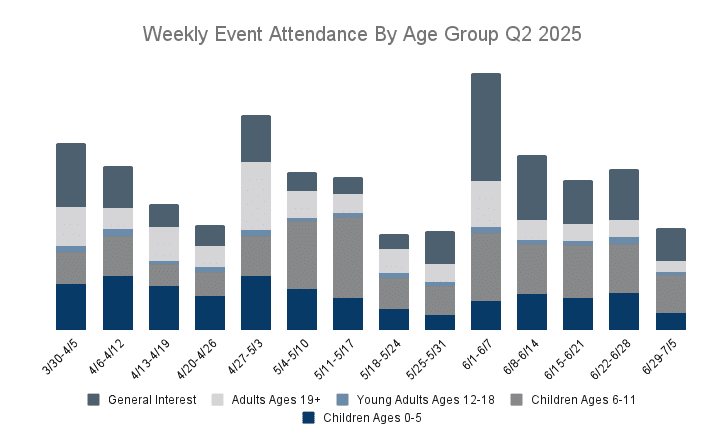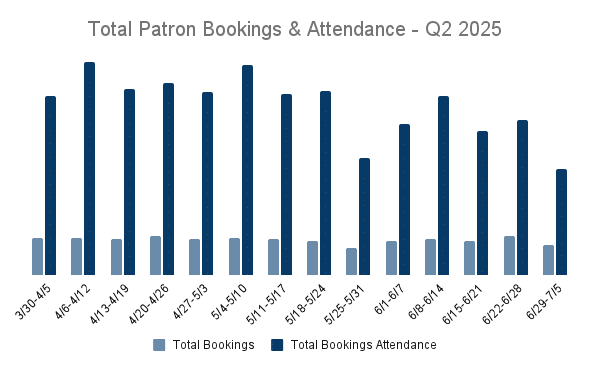Q2 2025 Library Service Usage Trends
Q2 2025 Library Trends & Highlights
Throughout the second quarter of 2025, libraries effectively responded to seasonal trends, demonstrating strong community engagement through carefully tailored programming. Event attendance reflected predictable variations around holidays and special library initiatives, particularly evident with the strong start of Summer Reading Programs. Meeting room bookings remained consistent, with a slight decrease during peak Summer Reading weeks when programming required extra space. Additionally, library WiFi usage remained steady with similar holiday lulls, highlighting the libraries’ essential role as hubs for connectivity during high-engagement periods.
Programming Overview
Weekly event attendance illustrated clear seasonal patterns, including expected declines around holidays such as Easter and Memorial Day. Notably, attendance surged significantly during the non-holiday week of April 27 particularly for the adult age group, underscoring effective programming strategies in less disrupted periods.
Children’s programming experienced substantial growth, potentially because the school year ended and families began seeking summer educational and recreational opportunities. The early June launch of Summer Reading Programs substantially increased attendance, marking the highest participation rates of the quarter across most age groups. These trends emphasize libraries’ critical role in supporting community literacy and education during summer breaks.
Rooms & Maker Space Utilization
Meeting room usage continued to align closely with overall library visitation patterns. Although bookings predictably decreased during holiday weeks such as Memorial Day, activity notably rebounded in early June.
Increased room & maker space utilization followed holidays during these periods as well. A slight decrease in bookings occurred during peak Summer Reading weeks, as rooms were often repurposed for library-hosted events, demonstrating the flexibility and adaptability of library spaces.
Question Sets Updates
This quarter, libraries successfully utilized Question Sets to simplify reporting processes, notably enabling better preparedness and faster submission of state annual surveys utilizing WhoFi platform. By entering data consistently throughout the year, libraries significantly reduced year-end reporting efforts.
“Using WhoFi’s Question Sets cut my time in half when completing the annual report. -It’s much quicker to access what I need compared to running separate reports from [other] software. Overall, it’s been a positive experience and a real time-saver.” – Avoca Public Library, Sabrina Lewis
The streamlined reporting offered by Question Sets allowed library staff to quickly and accurately demonstrate their community impact, effectively supporting informed discussions with library boards and stakeholders.
Library WiFi Usage Trends
Library WiFi usage remained steady overall, peak usage during the week of May 4th and lowest usage the week of Memorial Day, likely due to closures. Usage did not see the same increase as programs at the start of Summer Reading, possibly due to larger numbers of children ages 0-11 who may not have used WiFi connected devices These results reflectlibraries’ continued importance as essential connectivity providers, especially during periods of increased community engagement.
Looking Forward – Advocacy and Funding Opportunities
Public libraries nationwide continue navigating funding challenges. That said, communities are proactively preparing for these shifts with strategic optimism. Many are viewing these times as opportunities to reinforce the value and significance of libraries through compelling, data-supported advocacy.
The Importance of Advocacy Supported by Data
Effective advocacy is strengthened by comprehensive, accurate data. Libraries with great stories paired with clear programming, and community engagement information are prepared to communicate their value to stakeholders.
Using Data to Inform Stakeholders
- Clear Reporting: Consistent data collection through tools like Question Sets equips libraries with vital insights to demonstrate community engagement and programming success.
- Informed Decision-making: Libraries with robust service information can confidently advocate for funding, clearly articulating their contributions and impact within communities.
- Proactive Approaches: States that proactively utilize detailed library statistics are positively positioned to meet funding challenges and secure continued support for essential library services.

Looking to the Future
The current environment presents libraries with unique opportunities to clearly illustrate their indispensable role in communities. Encouraging trends in event participation, space utilization, as well as WiFi connectivity highlight libraries’ growing importance as versatile community resources. By continuing to document their successes through accurate and compelling data, libraries effectively communicate their value, strengthen their position with stakeholders and secure ongoing community support.
Interested in understanding your library or community space’s impact even better?
WhoFi helps you effortlessly gather insights, streamline reporting, and clearly communicate your community value. Book a call today—we’ll follow up with a brief meeting to learn about your community space!




